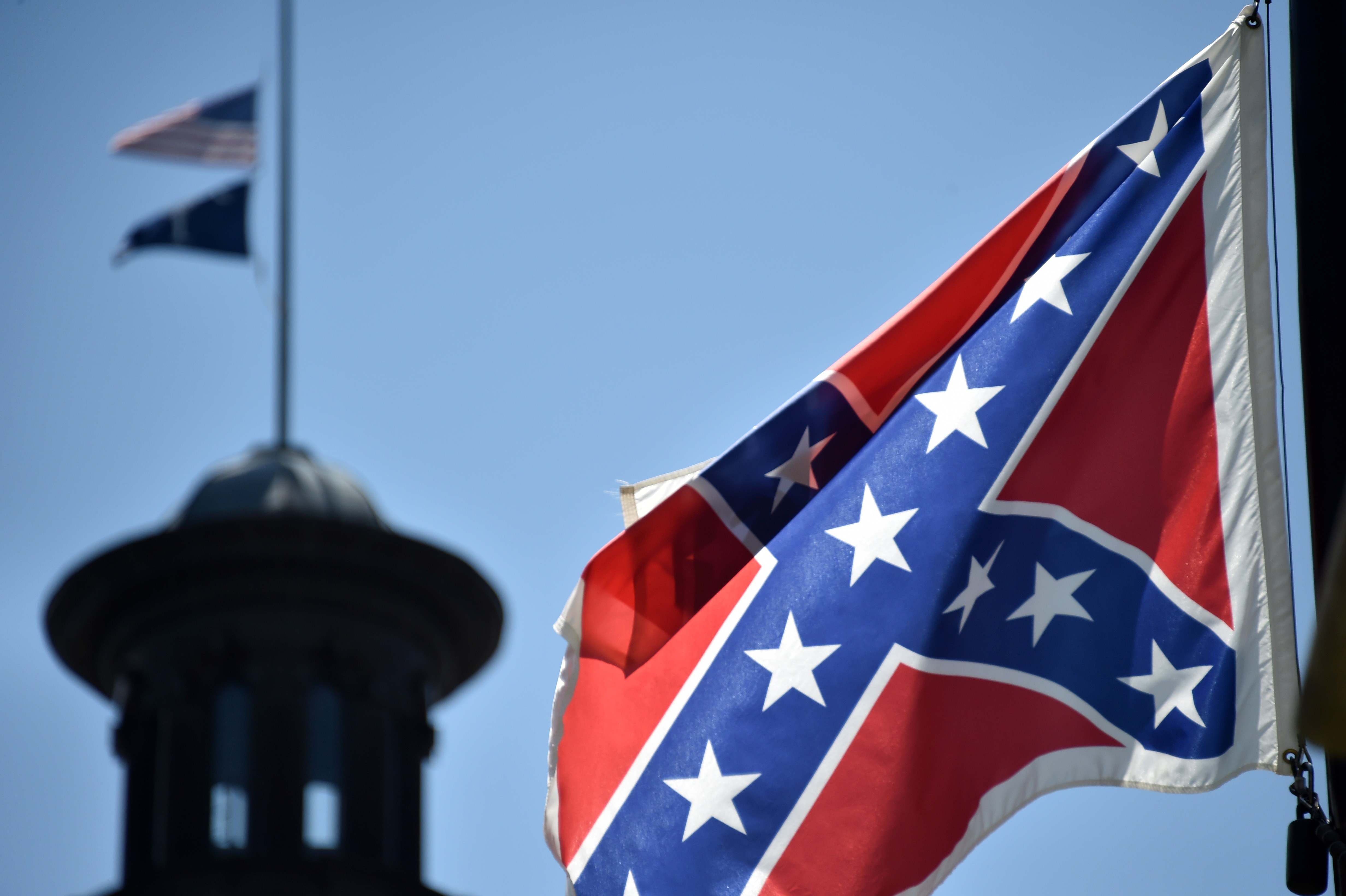I am a Southerner by both birth and heritage. I come from a long line of poor white cotton farmers on both sides of my family. Three of my four great-grandfathers fought in the Confederate Army. The fourth had been told by his parents that he could join the army when he turned 13; he was on his way from Texas to Virginia to do so when he met his brothers coming home on the road. They told him that Lee had surrendered and the war was over. My grandmother was a member of the United Daughters of the Confederacy and I was enrolled at the age of 6 in the Children of the Confederacy. I mention these credentials because of what I am about to say about the Confederate battle flag.
Newspaper accounts of the States Rights Democratic Party convention in Birmingham, Alabama, describe delegates marching into the auditorium under Confederate battle flags as bands played “Dixie.” This set the stage for the adoption of the battle flag by the Ku Klux Klan and the White Citizens Councils across the South as a symbol of their racist opposition to integration.
The flag that is causing such a furor was not “the Confederate flag,” as so many news reports have described it. It was a military flag, originally square in form, designed by William Porcher Miles, an aide to General P.G.T. Beauregard, after the first Battle of Manassas, because Beauregard thought that the Confederate national flag, which had a circle of white stars in a blue canton and three broad stripes, red, white, and red, was too easily confused with the Union flag in the smoke of battle. Miles’s battle flag was never approved by the Confederate Congress and never adopted as a national flag. It never flew over Confederate government offices, or over the Capitol at Richmond.
It was not even prominent among the symbols of the Lost Cause that helped create the myth of the noble suffering South during the years after the Civil War, nor was it celebrated during those years as a hallowed symbol of the Southern past, as apologists for it claim. According to University of Mississippi historian Allen Cabaniss, writing in The Encyclopedia of Southern Culture, it was seldom displayed at Confederate reunions or used by any of the societies of descendants of Confederate veterans. My grandmother’s United Daughters of the Confederacy chapter used the first national flag, the one that Beauregard thought could be confused with the Union flag, at their meetings, and she made me a small one out of silk to hang in my bedroom.
Cabaniss describes how the Confederate battle flag emerged “out of limbo” as a symbol of white supremacy and segregation during the Dixiecrat political campaign of 1948, when Strom Thurmond of South Carolina ran for president on a platform of states’ rights and segregation. Newspaper accounts of the States Rights Democratic Party convention in Birmingham, Alabama, describe delegates marching into the auditorium under Confederate battle flags as bands played “Dixie.” This set the stage for the adoption of the battle flag by the Ku Klux Klan and the White Citizens Councils across the South as a symbol of their racist opposition to integration. The first time I can remember seeing a picture of the battle flag carried in public was during the Clinton, Tennessee, race riot in 1956, when hooded Klansmen descended on the town and paraded down the main street under the flag. When it was at its peak, in the 1920s, the Klan’s members paraded under the American flag.
The fact is that in the 1950s and 1960s, the Confederate battle flag was hijacked and dishonored by racists and white supremacists who were opposed to the Federal government’s implementation of the 1954 Brown vs. Board of Education Supreme Court decision ending public school segregation. Two years after the decision, in 1956, the Georgia Legislature incorporated the battle flag into the state flag as a protest against integration. The battle flag was first raised over the South Carolina state Capitol on April 11, 1961, to mark the beginning of the Civil War Centennial; in March 1962 the Legislature voted to leave it there as a protest against the civil rights movement. Its 20th century symbolism is clear to anyone who examines the historical record, and it is not something to honor or revere.
In June 1865, two months after the Confederate surrender, a Catholic priest named Abram Joseph Ryan, a former Confederate Army chaplain, published a poem entitled “The Conquered Banner.” Its seven stanzas urged Southerners to accept defeat and furl their flags. The final stanza reads:
Furl that banner, softly, slowly!
Treat it gently – it is holy –
For it droops above the dead.
Touch it not – unfold it never,
Let it droop there, furled forever,
For its people’s hopes are dead.
The poem was once a standard recitation piece in Southern households, including my grandmother’s. The racists of the 1950s should have heeded Father Ryan’s advice. Now it is definitely time to furl that banner.
Lonn Taylor is a historian and retired museum curator who lives in Fort Davis, Texas. He was a historian at the Smithsonian Institution’s National Museum of American History from 1984 to 2002 and is the author of The Star-Spangled Banner: The Flag That Inspired the National Anthem, among other publications.
Listen to Lonn Taylor’s commentary on Marfa (Texas) Public Radio




I wish to thank you, Mr. Taylor for the lesson in the History of the “Confederate Flag”–it was fascinating to read!
I hope it goes a long way to stop the knee jerk reactions around the country that have created such a furor amongst a poorly informed citizenry!
I think it’s tragic that it seems to be so inflammatory and that there are so many opinions generated by this lack of information that add to the set back of race relations that this country seems to be experiencing!
Father Ryan’s poem brought me to tears-thank you for sharing your insights and his beautiful, tender poem!
Sincerely Lynne C.Sondelski
Branford CT.
Where was there ever any honor? The obsession over honor was a desperate denial of the brutal shame of slavery. The Confederacy never could decide on a flag because the more white they included, the more it looked like a flag of surrender, which became their true flag.
If their soldiers were so honorable, why did the plantations maintain the cotton trade while allowing their soldiers to starve? Denial is the true heritage of the South.
Look away, look away, look away, Dixieland.
It’s an interesting point that Lonn Taylor makes about the history of the “Confederate” flag. But I passionately agree with Mr. Blaney, where was there any honor in the Confederate cause? Was the cruelty and injustice of slavery more honorable than the racism and segregation of the South in the 50’s and beyond? I’m shocked that Mr. Taylor can speak with pride in regard to his family’s participation in the Civil War and the United Daughters of the Confederacy. Best to keep those credentials in the closet.
Pauline You are also lacking in knowledge. The south fought the north on matters that had little to do with slavery. The war was over the economic issue of the South wanting to secede from the Union. Slavery became an issue well after the south lost their fight.
It was over economic issues of that involved free labor. From Slaves. Without the free labor of slaves the south’s economy would crumble. This insane argument that it wasn’t about slavery but economics misses this entire point that it was about the economics of slavery.
The flag of the Confederacy described by Mr. Taylor is in the upper left of this display:
There is a distinction to be made between the dishonorable cause of the South, and the honorable service of its soldiers in the war. Even in Vietnam, soldiers with doubts about America’s purpose served nonetheless on behalf of their nation. Many of us with Confederate ancestors believe that it’s perfectly appropriate to honor their service, while simultaneously recognizing the immorality and barbarity of slavery. Perhaps it’s the unspoken awareness of that contradiction that suffuses so much of Southern history with melancholy.
That was beautifully stated …
https://avalon.law.yale.edu/19th_century/csa_scarsec.aspd that the U.S. continued to allow it for 90 years after the Revolution. So in some sense everyone was culpable. The Confederate battle flag has come to emblemize it, however, because the CSA’s history was too short to stand for anything other than the fight to preserve slavery.
Ichthelite, that claim is demonstrably untrue, and one need only read the documents that South Carolina issued alongside the Order of Secession to prove it (https://avalon.law.yale.edu/19th_century/csa_scarsec.asp). The claims re economic and states’ rights all derive from the rights of states in the Constitution to permit ownership of slaves as property. It’s worth remembering that Great Britain introduced slavery under the Union Jack to the colonies, and that the USA permitted slavery for 85 years after the revolution. So in a sense we are all culpable. The reason why the Confederate battle flag has come to emblemize it is because the CSA’s history was too short for anything other than the fight to preserve slavery.
Thank you Lonn! well said.
It was a different time in history. The South was primarily agricultural economically based while the North was industrialized. The South was being treated unfairly by the North’s and Lincoln’s tariffs. Yes, the South had slaves, but so did the North. The South seceded because they wanted out of the Union and Lincoln could not have that and lose millions in tariff revenues to the union.
For your reading: https://www.southernheritage411.com/truehistory.php?th=003
The reason Lincoln levied such high taxes on the south was to basically to impose economic sanctions because of their use of slave labor.
crikey there are some really uneducated comments on here largely based on the winning sides version of events and the teaching of it ever since The debate over slavery reparations ignores Africans’ role in selling human being salso the first slaves brought to the americas was done by the portugese not the english who when they arrived brought over indentured slaves who were mostly of irish decent and who were available after a while to be free,even colored people owned slave in america the most notable one being william ellison jr..do yourselves a favour and get educated